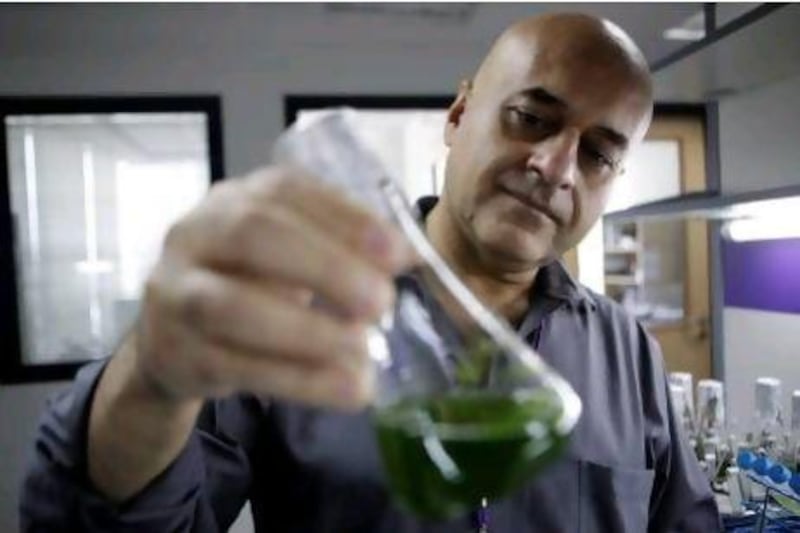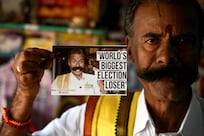The UAE's summer heat keeps most people indoors. But for Kourosh Salehi-Ashtiani, this is the hunting season.
The associate professor at New York University Abu Dhabi (NYUAD) is looking for the ultimate algae - one that can survive in waters that are both extremely salty and very hot. And where better to find them than here, in August?
When he does, he hopes to be able to cultivate them as a new source of biofuel. Not only can they withstand the harsh environment, but they can avoid being contaminated by other types of algae that cannot survive in such salty conditions.
"If you put a really nice algae in a normal outdoor artificial pond, you can risk other algae finding their way into the pond and starting to grow. If they grow fast, they can take over," he said.
Microalgae can be cultivated in various ways, but on a large scale, outdoor "raceway" ponds are among the most economical.
A powered paddle wheel constantly moves the water around these large, doughnut-shaped, shallow artificial ponds. The UAE is perfect for such ponds as there is plenty of land, and seawater.
But there are obstacles. To make the process commercially viable, the ponds need to yield about 60 grams of algae per square metre of pond, per day. Currently, their yield is around half that.
And the algae need to make plenty of oil. To do that, they often need to be stressed by limiting the amount of nitrogen available - but even then, not all types respond to the same degree.
Different strains, each producing a slightly different mix of oil and carbohydrates, grow at different rates
In some, the chemistry is very different, while other strains bear a much stronger resemblance to each other. Usually, the similarities turn out to be a family resemblance, between strains that have a relatively recent common ancestry.
But not always.
On the other side of the world in New York City, Prof Salehi-Ashtiani found a pond containing two putatively new strains that were morphologically similar to each other and to Chlamydomonas reinhardtii, the "model" species he has been studying.
He expected the two New York strains to be closely related to each other. But when he sequenced their genomes, there was a surprise - they were very different from his model organism. One appeared to make oil, and the other one did not.
"If we can understand why, then it can help us if we find a very interesting algae that does really well in a pond, but has a low oil production."
A detailed genetic understanding of the reasons why one makes oil while another does not would allow the algae's genes - and so their metabolism - to be tweaked to become more productive. That, though, means a lot of work to understand the plant's metabolic pathways.
A drawing of the metabolic pathways looks like an electronic circuit diagram, showing how molecules within the cell - mainly metabolites, such as sugars, lipids and amino acids - interact with each other.
It also shows exactly where, and under what circumstances, it generates energy, how it is uses that energy and how it produces its biomass - including oil.
But a single drawing is not enough. A cell is not a simple machine, operating in the same way all the time. Instead it changes according to its circumstances.
A particular set of conditions can cause it to switch genes on or off, fundamentally changing the chemical pathways in play.
Some algal genes are decidedly un-plantlike, and more typically found in animals, giving them a flexibility that neither plants nor animals can enjoy individually.
If the algae are growing in the sunlight, they will rely on photosynthesis for their food, and turn on the genes needed to grow as a plant.
But ifthey are growing in the dark, they might turn off their photosynthetic genes and absorb food from the environment as animals, fungi or bacteria would.
"It can live as a plant - just through CO2, light and some nitrogen - but it can also live as an animal, without any light.
"So in addition to being part plant and part animal, it also has a light and dark side, which makes it an extremely interesting system to study."
Prof Salehi-Ashtiani has mapped how these disparate sides interact. What he has found is "some very unexpected" differentiations of the metabolic subsystems, including oil and biomass production pathways. The genes respond differently to light and darkness: some turn off, and some turn on.
Once the metabolic pathways are properly understood, they can be represented mathematically, in equations that describe the network of metabolites and reactions.
That in turn can be used to guide the cloning of the genes that contain the enzymes that produce metabolites.
Of the 1,000 or so genes in C. reinhardtii's metabolic network, Prof Salehi-Ashtiani has already isolated a little more than half.
By cloning the genes, he confirms that the network is as he thought - giving him tools to tweak the algae's metabolism to make it produce more oil.
For example, when the starch production gene is mutated, starch production is blocked and so the algae suddenly start making more oil. Still other genes, as yet undiscovered, may achieve similar results by tweaking other pathways.
Until recently, Prof Salehi-Ashtiani has used the New York University's New York campus to get his results, but now the lab at NYUAD has its own gene sequencing machines, giving him better control over his experiments and saving time. As he says, "if you want to get something done right, you have to do it yourself."
And as summer kicked in, he has started on organising field trips to scour the area for more samples.
Some are close to home - he recently isolated a few strains literally in his back yard, in the soil behind the university's science and engineering block in Mussaffah.
But his real hope is for the mangrove forests. Those, he believes, could be hiding the really prime specimens.
"We're just trying to find that ultimate algae."






